#early modern florence
Text
In my past life in Academia I helped on the DECIMA project, which is a cool mapping tool of 16th century Florence.
Anyway, I was revisiting it for Reasons and forgot the opening line to their data page:
Florentine governments of the sixteenth and seventeenth centuries were obsessive data collectors, even if they didn’t always know what to do with all the data they collected.
Notary: We have oodles of information.
Signoria: Great. We love this.
Notary: And I presume you all have a plan for this.
Signoria:
Notary:
Signoria:
Notary: I ... presume there is...a plan? for this?
anyway, I recommend people play around with it! It's a cool tool and lots of fun. There are thematic maps as well as the main map based on data from the 1551 and 1632 population census and the 1561 property census.
#early modern history#early modern florence#renaissance florence#early modern italy#16th century#history
14 notes
·
View notes
Text
Mona Lisa (Do you understand what you're looking at?)
There are few things I'm willing to state definitively, but that this is the most famous painting in the "western" world, I've no doubt. You know the one:
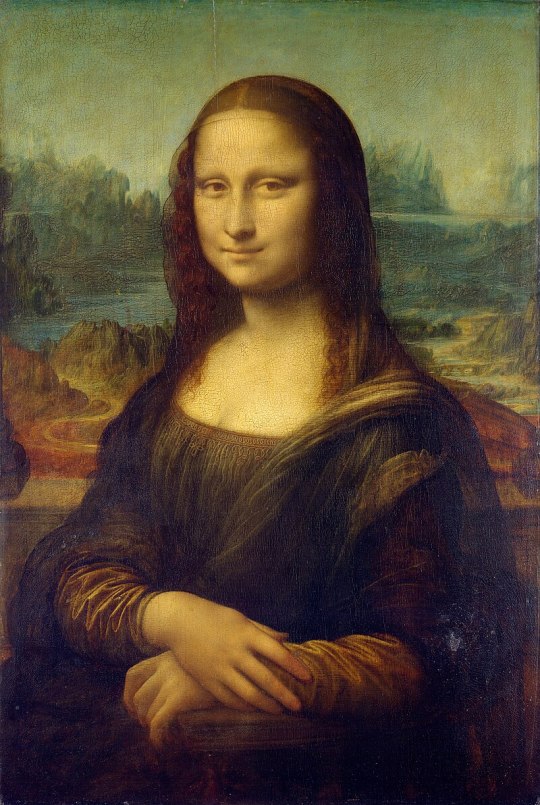
Mona Lisa, Leonardo da Vinci, 1503, oil on panel, 77x53cm
But why? Why is Mona Lisa so famous?
There's many elements to that answer. The first and simplest argument is the Mona Lisa is so very famous because we know so little about it, allowing us to invent mythologies for the work nearly as grand as the ones we invent for its painter. Leonardo da Vinci himself is a heavily mythologized figure, being inextricably linked to the invention of the "Renaissance" and to the invention of the artist as an individual and a genius - both forwarded by Giorgio Vasari's 1550 book, Lives of the Most Excellent Painters, Sculptors, and Architects (a topic worthy of a post unto itself). Of this ubiquitous character in history, this is his most famous, and ubiquitous, work.
And I do mean ubiquitous. Once you start looking for her, you'll find Lisa everywhere - on clothing, mugs, tchotchkes, reproductions, parodies, etc, etc, etc.

Mona Lisa? What are you doing in my falafel?
Another reason historians believe the Mona Lisa has experienced a rise to popularity few (see: no) other works can claim is precisely because it was stolen in the early 20th Century. A worker at the Louvre cut the painting from the frame, and though piece was ultimately recovered, being found under the thief's bed, it was arguably the sensationalized news story of this crime, more than the work of art itself, which launched its following.
(as a fun side note: if you've ever been to see the Mona Lisa in person and were disappointed by the size, rest knowing the painting we see today is indeed smaller than the original - there is believed to have been two columns and a ledge in the original - a difference owing to how many times it has been sliced from the frame)
So Mona Lisa has captured the public's imagination and launched this piece into pop culture stardom and a state of repeated reproduction and familiarity which has bestowed upon it a particular cultural cache.
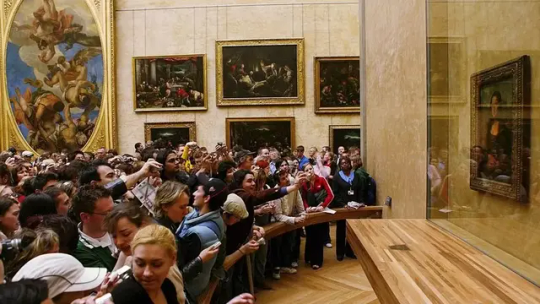
This next section is the important part, this is why I have titled this rant? essay? Do you understand what you're looking at?
The Mona Lisa is valued as one of the most important works of art today. The Mona Lisa was not considered particularly important, or even particularly good, at the time of its creation. It wasn't even the most noteworthy of da Vinci's works.
Let's work backwards.
How did this work, by a Florentine artist, ended up in Louvre?
Leonardo da Vinci lived in France for a time, completing work for the King, and it is where he ultimately died. All those works in his possession at the time of his death were claimed as property of the King, which were in turn seized by the French State following the French Revolution, and ultimately ended up on display in the Louvre.
This suggests this piece had essentially no viewing audience during da Vinci's lifetime.
Why was it in Leonardo da Vinci's possession at the time of his death?
The sitter has been identified as 24-year-old Italian noblewoman Lisa del Giocondo, and the work was likely a commission by her husband, Florentine silk merchant, Francesco di Bartolomeo del Giocondo, as a celebration of the birth of their second son. That this commission remained in da Vinci's possession suggests it was rejected upon completion.
Why was this portrait rejected by its patron?
This is the fun part: the Mona Lisa was probably rejected (and I say probably because this is pure inference and conjecture) because, for the time and setting, this is an unconventional depiction of a woman: she's presented as androgynous bordering on masculine, aggressive, without the requisite hallmarks of class and station, and, ahem, loose.
We have more extant portraits of women surviving from Florence in the quattrocento leading into the cinquecento than we do of men (approximately five are known of men, compared to 40 of women), and the majority of them have been identified as forming part of a donora or counter-donora (the dowry and counter-dowry) and thus follow specific rhetorical conventions. These paintings are both part of and proof of the economic and material exchange made in a marriage, of which the woman also is and is presented as an object in that exchange - sumptuously dressed and dripping in jewels, expressing the wealth of the families and the size of the dowry.
Now, this portrait is not intended to celebrate a donora, and given Lisa's age, she would have been subject to Florence's sumptuary legislation (until they were married and for three years after, girls were spared from these laws), so it makes some degree of sense that she is depicted in plain clothes and without jewelry (though that may have been taken as offensive by the wealthy patron).
But while her age and married state my excuse her dress, it damns her hair. Virgins and brides could wear their hair loose as a symbol of innocence, but married women were expected to keep their hair decorously concealed as a matter of propriety. That her hair is loose is erotic, it suggests she is loose. The implication is that Lisa has loose morals and is sexually promiscuous. This is scandalous!
(This is why likely why many copies, including Raphael's Pen and Ink Portrait Portrait of a Young Girl, 1505 age her down - if she is younger, everything is forgivable. But not with her apparent age)
The women in conventional portraits of the time are depicted with all the virtues of a woman - chastity, elegance, modesty. Their bodies were contained and limbs controlled, most commonly presented in profile with the eyes averted. But not Lisa! She is in 3/4 frontal view, gazing out at the viewer, in a manner that is a little aggressive. This painting is lifelike, that is, she has weight and volume, it seems as though you can see the blood moving beneath her skin. Rather than being concealed, her humanity is revealed. Her direct gaze, like her loose hair, is challenging and erotic, and coupled with her enigmatic smile she seems to be finding pleasure in her encounter with the viewer. Yet she maintains a sprezzatura, a cold aloofness prized in portraits of men but unheard of in portraits of women. And just look at her hands - for all they are relaxed they are active, set in a rhetorical expression which was typically reserved for portraits of men.
To answer the final question then, my best guess for why this painting was rejected by its patron is because it challenged traditional conventions of womanly presentation and behavior in a manner the patron found insulting, if not obscene.
So, what's my conclusion here? Honestly, this has all been an exercise in my own wonder and mystification. Here is a painting that is frankly radical, was in fact rejected for being too unconventional, that, by virtue of happenstance and coincidence rose to absurd levels of popularity - a state of fame which has served to make this unconventional painting the literal archetype of the conventions of the era.
And I see all these people flocking to the Louvre to see the Mona Lisa because it's a must-do, and I just have to ask, do you understand what you're looking at? Do you see the irony? Do you get how funny this entire story is?
#mona lisa#leonardo da vinci#renaissance art#renaissance#italy#history#art history#early modern europe#louvre#florence italy
0 notes
Text
Cross-posting an essay I wrote for my Patreon since the post is free and open to the public.

Hello everyone! I hope you're relaxing as best you can this holiday season. I recently went to see Miyazaki's latest Ghibli movie, The Boy and the Heron, and I had some thoughts about it. If you're into art historical allusions and gently cranky opinions, please enjoy. I've attached a downloadable PDF in the Patreon post if you'd prefer to read it that way. Apologies for the formatting of the endnotes! Patreon's text posting does not allow for superscripts, which means all my notations are in awkward parentheses. Please note that this writing contains some mild spoilers for The Boy and the Heron.

Hayao Miyazaki’s 2023 feature animated film The Boy and the Heron reads as an extended meditation on grief and legacy. The Master of a grand tower seeks a descendant to carry on his maddening duty, balancing toy blocks of magical stone upon which the entire fabric of his little pocket of reality rests. The world’s foundations are frail and fleeting, and can pass away into the cold void of space should he neglect to maintain this task. The Master’s desire to pass the torch undergirds much of the film’s narrative.

(Isle of the Dead. Arnold Böcklin. 1880. Oil on Canvas. Kunstmuseum. Basel, Switzerland.)
Arnold Böcklin, a Swiss Symbolist(1) painter, was born on October 16 in 1827, the same year the Swiss Evangelical Reformed Church bought a plot of land in Florence from the Grand Duke of Tuscany, Leopold II, that had long been used for the burials of Protestants around Florence. It is colloquially known as The English Cemetery, so called because it was the resting place of many Anglophones and Protestants around Tuscany, and Böcklin frequented this cemetery—his workshop was adjacent and his infant daughter Maria was buried there. In 1880, he drew inspiration from the cemetery, a lone plot of Protestant land among a sea of Catholic graveyards, and began to paint what would be the first of six images entitled Isle of the Dead. An oil on canvas piece, it depicts a moody little island mausoleum crowned with a gently swaying grove of cypresses, a type of tree common in European cemeteries and some of which are referred to as arborvitae. A figure on a boat, presumably Charon, ferries a soul toward the island and away from the viewer.
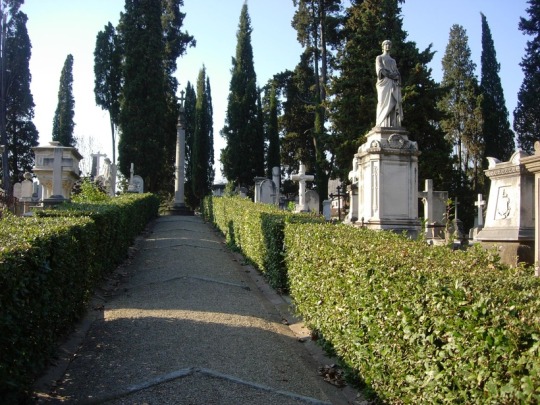
(Photo of The English Cemetery in Florence. Samuli Lintula. 2006.)
The Isle of the Dead paintings varied slightly from version to version, with figures and names added and removed to suit the needs of the time or the commissioner. The painting was glowingly referenced and remained fairly popular throughout the late 19th and early 20th centuries. The painting used to be inescapable in much of European popular culture. Professor Okulicz-Kozaryn, a philologist (someone with a deep interest in the ways language and cultural canons evolve)(2) observed that the painting, like many other works in its time, was itself iterative and became widely reiterated and referenced among its contemporaries. It became something like Romantic kitsch in the eyes of modern art critics, overwrought and excessively Byronic. I imagine Miyazaki might also resent a work of that level of manufactured ubiquity, as Miyazaki famously held Disney animated films in contempt (3). Miyazaki’s films are popularly aspirational to young animators and cartoonists, but gestures at imitation typically fall well short, often reducing Miyazaki’s weighty films to kitschy images of saccharine vibes and a lazy indulgence in a sort of empty magical domestic coziness. Being trapped in a realm of rote sentiment by an uncritical, unthoughtful viewership is its own Isle of Death.

(Still from The Boy and the Heron, 2023. Studio Ghibli.)
The Boy and the Heron follows a familiar narrative arc to many of Miyazaki’s other films: a child must journey through a magical and quietly menacing world in order to rescue their loved ones. This arc is an echo of Satsuki’s journey to find Mei in My Neighbor Totoro (1988) and Chihiro’s journey to rescue her parents Spirited Away (2001). To better understand Miyazaki’s fixation with this particular character journey, it can be instructive to watch Lev Atamanov’s 1957 animated film, The Snow Queen (4)(5), a beautifully realized take on Hans Christian Andersen’s 1844 children’s story (6)(7). Mahito’s journey continues in this tradition, as the boy travels into a painted world to rescue his new stepmother from a mysterious tower.
Throughout the film, Miyazaki visually references Isle of the Dead. Transported to a surreal world, Mahito initially awakens on a little green island with a gated mausoleum crowned with cypress trees. He is accosted by hungry pelicans before being rescued by a fisherwoman named Kiriko. After a day of catching and gutting fish, Mahito wakes up under the fisherwoman’s dining table, surrounded by kokeshi—little wooden dolls—in the shapes of the old women who run Mahito’s family’s rural household. Mahito is told they must not be touched, as the kokeshi are wards set up for his protection. There is a popular urban legend associated with the kokeshi wherein they act as stand-ins for victims of infanticide, though there seems to be very little available writing to support this legend. Still, it’s a neat little trick that Miyazaki pulls, placing a stray reference to a local legend of unverifiable provenance that persists in the popular imagination, like the effect of fairy stories passed on through oral retellings, continually remolded each new iteration.
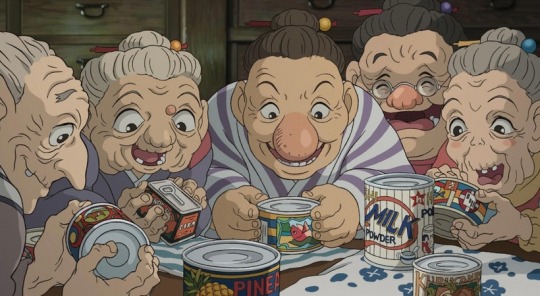
(Still from The Boy and the Heron, 2023. Studio Ghibli.)
Kiriko’s job in this strange landscape is to catch fish to nourish unborn spirits, the adorable floating warawara, before they can attempt to ascend on a journey into the world of the living. Their journey is thwarted by flocks of supernatural pelicans, who swarm the warawara and devour them. This seems to nod to the association of pelicans with death in mythologies around the world, especially in relationship to children (8). Miyazaki’s pelicans contemplate the passing of their generations as each successive generation seems to regress, their capacity to fulfill their roles steadily diminishing.
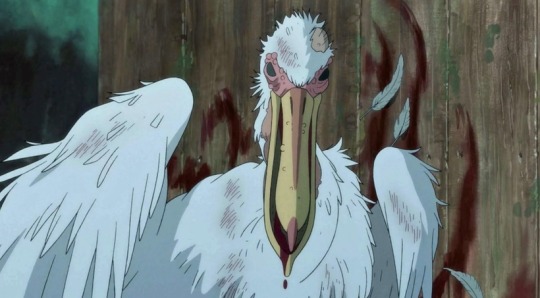
(Still from The Boy and the Heron, 2023. Studio Ghibli.)
As Mahito’s adventure continues, we find the landscapes changing away from Böcklin’s Isle of the Dead into more familiar Ghibli territories as we start to see spaces inspired by one of Studio Ghibli’s aesthetic mainstays, Naohisa Inoue and his explorations of the fantasy realms of Iblard. He might be most familiar to Ghibli enthusiasts as the background artists for the more fantastical elements of Whisper of the Heart (1995).

(Naohisa Inoue, for Iblard Jikan, 2007. Studio Ghibli.)
By the time we arrive at the climax of The Boy and the Heron, the fantasy island environment starts to resemble English takes on Italian gardens, the likes of which captivated illustrators and commercial artists of the early 20th century such as Maxfield Parrish. This appears to be a return to one of Böcklin’s later paintings, The Island of Life (1888), a somewhat tongue-in-cheek reaction to the overwhelming presence of Isle of the Dead in his life and career. The Island of Life depicts a little spot of land amid an ocean very like the one on which Isle of the Dead’s somber mausoleum is depicted, except this time the figures are lively and engaged with each other, the vegetation lush and colorful, replete with pink flowers and palm fronds.

(Island of Life. Arnold Böcklin. Oil on canvas. 1888. Kunstmuseum. Basel, Switzerland.)
In 2022, Russia’s State Hermitage Museum in Saint Petersburg acquired the sixth and final Isle of the Dead painting. In the last year of his life, Arnold Böcklin would paint this image in collaboration with his son Carlo Böcklin, himself an artist and an architect. Arnold Böcklin spent three years painting the same image three times over at the site of his infant daughter’s grave, trapped on the Isle of the Dead. By the time of his death in 1901 at age 74, Böcklin would be survived by only five of his fourteen children. That the final Isle of the Dead painting would be a collaboration between father and son seemed a little ironic considering Hayao Miyazaki’s reticence in passing on his own legacy. Like the old Master in The Boy and the Heron, Miyazaki finds himself with no true successors.
The Master of the Tower's beautiful islands of painted glass fade into nothing as Mahito, his only worthy descendant, departs to live his own life, fulfilling the thesis of Genzaburo Yoshino’s 1937 book How Do You Live?, published three years after Carlo Böcklin’s death. In evoking Yoshino and Böcklin’s works, Hayao Miyazaki’s The Boy and the Heron suggests that, like his character the Master, Miyazaki himself must make peace with the notion that he has no heirs to his legacy, and that those whom he wished to follow in his footsteps might be best served by finding their own paths.
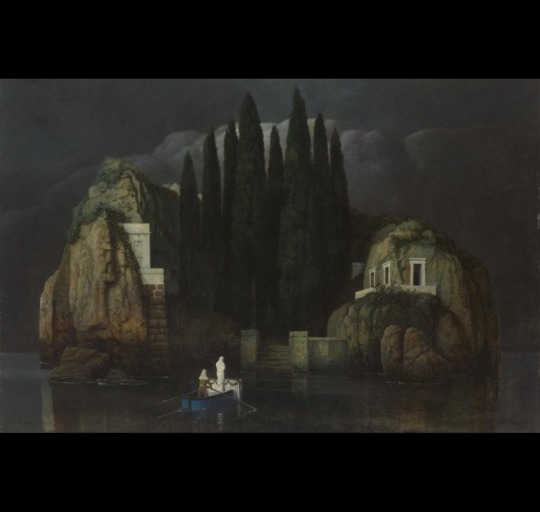
(Isle of the Dead. Arnold and Carlo Böcklin. Oil on canvas. 1901. The State Hermitage Museum. Saint Petersburg, Russia.)
INFORMAL ENDNOTES
1 - Symbolists are sort of tough to nail down. They were started as a literary movement to 1 distinguish themselves from the Decadents, but their manifesto was so vague that critics and academics fight about it to this day. The long and the short of it is that the Symbolists made generous use of a lot of metaphorical imagery in their work. They borrow a lot of icons from antiquity, echo the moody aesthetics from the Romantics, maintained an emphasis on figurative imagery more so than the Surrealists, and were only slightly more technically married to the trappings of traditionalist academic painters than Modernists and Impressionists. They're extremely vibes-forward.
2 - Okulicz-Kozaryn, Radosław. Predilection of Modernism for Variations. Ciulionis' Serenity among Different Developments of the Theme of Toteninsel. ACTA Academiae Artium Vilnensis 59. 2010. The article is incredibly cranky and very funny to read in parts. Contains a lot of observations I found to be helpful in placing Isle of the Dead within its context.
3 - "From my perspective, even if they are lightweight in nature, the more popular and common films still must be filled with a purity of emotion. There are few barriers to entry into these films-they will invite anyone in but the barriers to exit must be high and purifying. Films must also not be produced out of idle nervousness or boredom, or be used to recognise, emphasise, or amplify vulgarity. And in that context, I must say that I hate Disney's works. The barrier to both the entry and exit of Disney films is too low and too wide. To me, they show nothing but contempt for the audience." from Miyazaki's own writing in his collection of essays, Starting Point, published in 2014 from VIZ Media.
4 - You can watch the movie here in its original Russian with English closed captions here.
5 If you want to learn more about the making of Atamanoy's The Snow Queen, Animation Obsessive wrote a neat little article about it. It's a good overview, though I have to gently disagree with some of its conclusions about the irony of Miyazaki hating Disney and loving Snow Queen, which draws inspiration from Bambi. Feature film animation as we know it hadonly been around a few decades by 1957, and I find it specious, particularly as a comic artistand author, to see someone conflating an entire form with the character of its content, especially in the relative infancy of the form. But that's just one hot take. The rest of the essay is lovely.
6 - Miyazaki loves this movie. He blurbed it in a Japanese re-release of it in 2007.
7 - Julia Alekseyeva interprets Princess Mononoke as an iteration of Atamanov's The Snow Queen, arguing that San, the wolf princess, is Miyazaki's homage to Atamanoy's little robber girl character.
8 - Hart, George. The Routledge Dictionary of Egyptian Gods And Goddesses. Routledge Dictionaries. Abingdon, United Kingdom: Routledge. 2005.
#hayao miyazaki#the boy and the heron#how do you live#arnold böcklin#carlo böcklin#symbolists#symbolism#animation#the snow queen#lev atamanov#naohisa inoue#the endnotes are very very informal aksjlsksakjd#sorry to actual essayists
505 notes
·
View notes
Note
what part of italy are machete and vasco from? not their birthplace since from what i've seen you're still workshopping that. where do they live? i assume rome?
In the 1500's setting Vasco lives and was born in Florence, his family has lived there for centuries. Machete was born in Sicily, was taken to Naples to serve as an apprentice and ended up living and working in Rome (and more specifically today's Vatican city, which as you may know has been an independent country since 1929 but wasn't back then). They first met when they were both studying in Venice in their late teens/early twenties.
I think in the modern au they live together somewhere in Florence.
#characters travelling this extensively at the time#from one end of the country to another#may not be very realistic but it's more fun to include a variety of interesting historical locations#let me be greedy and self indulgent for a moment#(not to mention that Italy wasn't unified until late 1800's and was instead made of various states kingdoms and duchies#that didn't always get along with each other that well and were culturally and linguistically diverse#and some of them were actually ruled Spain and Austria for example)#I say this as lovingly as possible but the history of Italian peninsula as a whole is just a real clusterfuck#I feel like I still haven't wrapped my head around it adequately to be explaining any of this to you#but please be patient with me I promise I'm trying my best#answered#anonymous
185 notes
·
View notes
Text
I think the main thing that absolutely infuriates me about the "Romeo and Juliet were just dumb, horny teens" take is this implication that because they were so young, their relationship had to boil down to them being dramatic and inventing some great romance to moan about, or lust and hormones. As a teenager, it makes me want to tear the speaker apart with my bare hands. Interchangeably with stabbing, maybe.
When you look at the text, you can clearly see that there is some emotional connection between Juliet and Romeo. Their first conversation is literally a sonnet - which already indicates some sort of understanding and mutuality, and it's also beautiful poetry. They are the only characters in the entire play that they are really fully comfortable talking to. The adults are caught up in the feud, Nurse loves Juliet, but cannot understand her (and makes a dirty joke at her expense in Act I, which for a person Juliet's age would be awfully unpleasant), Romeo's friends, though I Iove them, don't get his sensitivity - Mercutio laughing at it and Benvolio worried by it - which Juliet, in turn, appreciates. They speak of each other with respect and admiration, quite unusually in Verona, where all is conflict and even Juliet's own father insults her: look at the sonnet, the balcony scene, Romeo comparing his sweetheart to the sun or a jewel (in contrast to his earlier quotes about Rosaline, which are literally a compilation of clichés stacked on top of one another). Even when Juliet awaits their wedding night, in a speech clearly centered on sexual matters, there is a visible softness and affection with which she treats Romeo ("cut him out in little stars"...). She waits for the night because it's him, not "I want to sleep with someone because I want to sleep with someone". The two genuinely care about each other, and are fond of each other. Of course, we can wonder if this love would last if they were given an opportunity to grow older, but when the play takes place, this love is there, and it's beautiful.
(Off-topic, I'd also like to note that this is an Elizabethan play that takes place in even earlier times, presumably late medieval - early renaissance Italy. They wouldn't live in the modern world where you can date many different people and settle well into your thirties or fourties. The average marriage age for girls in Shakespeare's time was about twenty, in fifteenth century Florence it was eighteen. Both of them were from wealthy families, so they'd likely be expected - even if Juliet's parents did not force her into a marriage with Paris - to marry earlier, for financial and political purposes. There couldn't be a "growing older" like we imagine it. Even their hypothetical different relationships would be early relationships for today's standards)
And it makes my blood boil when the visible genuine bond between these two is reduced to just "dumb kids being horny". The motive behind these words being partly, of course, the high-school-acquired All Required Reading is Nonsense edginess, but also a deeper issue - the inability to comprehend the fact that teenage love is also often real love.
Being capable of having deep and meaningful romantic relationships does not come baked into your birthday cake when you turn eighteen or attached to your first ever bill. Not every single feeling a teenager might harbour is at its core shallow lust and wanting to get laid. Of course, there's lots of cases of shortsighted infatuation where the pair really have nothing in common! I could name at least a few examples I have seen personally. But still, on every street and every corner of the world, and often a few metres from these pointless infatuations, teens fall in love because there's something more to it. Because they find they have a lot in common, because they get along well with each other, because they are able to see the good in the other person - their kindness, their intelligence, their enthusiasm, you name it. "Teens" including the younger teens, from thirteen to fifteen. And this love is a deep emotional bond. Sure, in most cases it will not last until death (and to be honest, relationships not working out is not really a teenage-specific phenomenon and a sign that young love of all is inherently doomed and it has to die so the curse of growing up is fulfilled), but it doesn't make it less of a love when it still remains, and it includes all the things love is about. Young couples go on dates, and have fun. They confide in each other. They support each other through hard times, they show care, they sometimes make sacrifices for their loved one's good. As any person in love does, at any age.
When I fell in love four months ago, I did not fall in love because I wanted to sleep with someone so bad. In fact, I do not want to - not for the next several years. I realise it's something I might want someday, but it's not today; and above all, I'm way too young. If anything, what I want is to kiss someone, or run my fingers through his hair, or read with his head in my lap - but it's not something I'd go out of my way and date a random person to get, come on. I fell in love because he is actually the first boy that reminds me of myself so much, the first I can understand so well. Because I also have a penchant for history and writing, I also tend to use formal and flowery language in very informal situations, I also enjoy people's attention (though I seem to worry more about being a potential inconvenience than he does), I also believe that we should judge people as individuals, because there's too much nuance in one person to make proper statements about large groups - and I find in him so many things that I can relate to, though of course I can't say I know him well enough to speak much for sure. Besides, he's simply a wonderful person, not flawless, of course, but he has a good heart. He is always kind, and well-mannered, and intelligent, and you can laugh with him. He would care if something bad happened, no matter if he says that he wouldn't. I think I know him well enough to say this at least. And if he loved me back (a thing I consider unlikely for now, but not entirely impossible), would we stay together forever? Heaven alone knows! Maybe not! It is up to the higher power. But even if we broke up, that wouldn't erase the fact that I loved him, and I would have done a lot for him, and we were able to have meaningful conversations. Just because a love isn't forever, doesn't mean it was never there.
Because - what the "dumb kids" people don't seem to grasp - teenagers are also human beings with a functioning, even if not fully developed, brain, capable of having complex feelings and thoughts just like an adult. Note that Shakespeare's leads, at least Juliet, actually do that - hence the pre-wedding night monologue, the "deny thy father and refuse thy name", her statement (I don't know the English original of that one, to be honest) that she is too soft and loving towards Romeo already, but it's because she has such profound feelings for him she can't even pretend to be strict. It's noticeable that she has some emotional maturity, at least - she shows some critical thinking abilities, she understands the consequences of many actions, she is able to see that the feud is pointless and a name is just a name. She's a teenager, and someone in their teens is also a Homo sapiens specimen, not a being from a different planet. Teens think and feel. It might not be the same reality as the adult one, and they don't deal with emotions with such ease as an adult would, but that doesn't mean they are unable to truly love and care, to enjoy talking to someone and want the best for them, like grown-ups do - as developing an affection for someone that makes you happy is a very human thing, and I can guarantee you a thirteen or fourteen-year-old is a developed enough human being to experience it.
So, to sum it up, if I hear any "Romeo and Juliet were just dumb kids being horny" on my watch, the author of this statement will presumably be mercilessly killed, and then I'll do as Fulvia allegedly did to Cicero and stab something through their tongue, except instead of a hairpin, I'll probably use one of the darts my little brother got for Christmas. They are very sharp. We have several holes in the floor already.
#and today I live up to my URL and write a full-blown essay#romeo and juliet#shakespeare#classic literature#my Romeo and Juliet rants
91 notes
·
View notes
Text
A Night in Italy - Toto Wolff.
warning - fluff fluff nothing much, I don't think so, I mean it's a toto wolff fanfic
summary - just a beautiful exchange between a girl name hannah and Toto, how he becomes from a stranger to a familiar stranger, it beautiful
P.S - guys I want to make this a series, please let me know if I can make it better, not proofread
In the heart of Florence, where ancient wonders and modern delights coexisted harmoniously, two souls found themselves drawn together by fate. Toto, a charismatic and adventurous man with a deep passion for cars and motorsports, had always been fascinated by the bustling cafés of Italy. One summer evening, as the sun dipped low on the horizon, casting a golden glow over the cobblestone streets, he found himself wandering into a charming café.
As Toto entered the cozy establishment, he couldn't help but notice a captivating figure sitting alone at a corner table. Her name was Hannah, an accomplished orthopedic surgeon, her presence exuding intelligence and grace. She was engrossed in a book, seemingly unaware of the world around her.
Something inside Toto stirred as he watched her, and he knew he couldn't resist the urge to speak to her. With a deep breath, he approached her table, feeling both nervous and excited. "Excuse me," he said, his voice gentle yet filled with warmth, "I hope I'm not intruding, but I couldn't help but notice you from across the café. Would you mind if I join you for a moment?"
Hannah looked up, her eyes meeting Toto's with a hint of surprise. She hesitated for a brief moment, but the sincerity in his eyes made her feel strangely at ease. "Sure," she replied with a smile, gesturing to the chair across from her.
Toto took the seat gratefully, introducing himself to Hannah. The conversation between them flowed effortlessly, as if they were old friends catching up after a long time apart. They spoke about their shared passion for cars and motorsports, exchanging stories about their favorite racing events and drivers. Toto, with his vast knowledge of automotive engineering, fascinated Hannah, and she, in turn, captivated him with her dedication to her profession and her insights into the world of medicine.
As the evening progressed, the café slowly filled with the soft glow of sunset, bathing the surroundings in a warm, romantic light. Hannah checked the time on her watch, realizing that she had spent several hours talking to this friendly stranger named Toto. "I should be heading home," she said, a hint of reluctance in her voice. "It's getting late, and I have an early start at the hospital tomorrow."
Toto understood the practicality of her decision, but he couldn't bear the thought of saying goodbye just yet. "I completely understand, Hannah," he said softly, "but what if we continued this delightful evening with dinner? There's a wonderful trattoria nearby, and I promise it'll be worth your time."
Hannah was taken aback by the invitation. Normally, she would be cautious about such spontaneity, but something about Toto's presence made her want to step out of her comfort zone. "Alright," she agreed, a hint of a smile tugging at the corners of her lips, "one more adventure for the night."
They made their way through the charming streets of Florence, the city's history and romance surrounding them as they walked side by side. The trattoria Toto had recommended was a quaint and intimate place, perfect for an unforgettable evening.
Over a delicious dinner, they continued their conversation, delving deeper into their lives, hopes, and dreams. As the night wore on, they laughed freely and shared stories that left them feeling like kindred spirits. Each moment spent together seemed to strengthen the connection between them, weaving an unbreakable bond that neither of them could fully comprehend.
Bottles of wine were brought to their table, and as the hours slipped away unnoticed, they lost track of time. The wine served as a catalyst for their candid conversations, allowing them to reveal their vulnerabilities and aspirations without hesitation.
Hannah couldn't help but feel an overwhelming sense of comfort in Toto's company. He was a stranger just hours ago, yet now, she felt as if she had known him for a lifetime. The walls she had built around her heart, hardened by the demands of her profession, began to crumble under the weight of this inexplicable connection.
As the clock approached 3 am, the realization that they had been lost in each other's presence all night hit them. Hannah's heart was filled with a mix of emotions she couldn't fully comprehend. She had fallen for this familiar stranger, and it scared and excited her in equal measure.
Toto, too, was smitten by Hannah's intellect, compassion, and adventurous spirit. The ease with which they connected and the way they understood each other felt like a once-in-a-lifetime encounter.
With the night coming to a close, Toto walked Hannah back to her car, the silence between them filled with the unspoken emotions that lay heavy in the air. As they stood under the moonlight, a soft breeze carrying the scent of flowers, they found themselves embracing, their hearts racing in sync.
"Hannah," Toto began, his voice gentle and earnest, "from the moment I saw you at that café, I knew there was something extraordinary about you. I've never felt such an instant connection with anyone before. I know we just met, but I can't ignore what I feel."
Hannah looked into Toto's eyes, her heart fluttering as she realized she felt the same way. "Toto, this is all so unexpected, but I can't deny that there's something between us. I've never met someone who understands me so completely. It's like we've known each other for ages."
Toto smiled, his eyes shining with affection. "I don't want this night to be the end of our story, Hannah. Can I see you again?"
Hannah's heart swelled with happiness as she replied, "Yes, I'd like that very much. Let's exchange numbers and find a way to meet again."
And so, they exchanged contact information, each feeling a sense of excitement and hope for what the future held. As they parted ways that night, their hearts felt lighter, knowing that something magical had unfolded between them.
In the days that followed, Toto and Hannah continued their conversations, growing closer with each passing moment. They found themselves making time for each other despite their demanding schedules, eager to explore the depths of their connection.
They shared countless adventures in the picturesque streets of Italy, embarking on road trips to the countryside and wandering through historical landmarks hand in hand. The bond between them deepened, and their love blossomed amidst the timeless beauty of Italy.
As summer turned to autumn and autumn to winter, their love story thrived, with each season marking a new chapter in their lives. Hannah found herself opening up to love in ways she never thought possible, and Toto discovered a sense of belonging he had never experienced before.
On a crisp winter's evening, Toto took Hannah to a secluded spot overlooking the city of Florence, where the lights twinkled like stars in the night sky. Under the shimmering moonlight, he got down on one knee, his heart pounding in his chest.
"Hannah," Toto said, his voice filled with emotion, "you've brought so much joy and meaning into my life. With you, I've found a love I never knew was possible. You've become the light of my world, and I can't imagine my life without you. Will you do me the great honor of being my partner in this beautiful journey called life?"
Tears glistened in Hannah's eyes as she looked into Toto's earnest gaze. Her heart felt full, and she knew that this love was unlike anything she had ever known. "Yes, Toto," she whispered, her voice barely above a breath, "I love you, and I would be honored to share my life with you."
Their love story continued to unfold, a tale of two hearts finding solace and joy in each other's love. Together, they faced life's challenges with unwavering support, cherishing every moment they spent in each other's arms.
In the heart of Italy, amidst the ancient wonders and the modern delights, Toto and Hannah had found a love that transcended time and place. Their love story became a testament to the magic of destiny and the power of connection, proving that sometimes, the most extraordinary love stories begin with a chance encounter in a café on a summer evening in Italy.
#toto wolff#tw#toto#wolff#troger christian wolff#f1#formula 1#formula one#f1 imagine#f1 fic#f1 fanfic#f1 fanfiction#f1 x reader#f1 x you#social media au#instagram au#instagram imagine#toto wolff imagine#toto wolff x reader#toto wolff x you#toto wolff fic#toto wolff fluff#toto wolff fanfic#toto wolff blurb#mercedes amg f1#f1 instagram au#instagram edit#f1 blurb#fake instagram#f1 fandom
199 notes
·
View notes
Text
Dr James Barry, the Transgender Man who Became British Colonial Medical Inspector in 1822

The Vagina Museum tells the story of the transgender man who became a famous military surgeon in Britain in the 19th century.
Dr James Barry (circa 1789-1865) was a renowned military surgeon who is probably better known for the speculation about his gender than his illustrious career. So let's set the record straight about the work of this brilliant healer.
A famous surgeon outed after death
James Barry was assigned female at birth. This was only revealed after his death. The fact was made public as the woman who laid his body out after his death was disgruntled at not being paid for her work, so she ended up taking a story about his body to the press.
The story was somewhat newsworthy because in his lifetime, Barry was a famous surgeon, something of a rockstar in the military and surgical worlds.
It's hard to tease out details of Barry's early life due to posthumous speculation - once the news broke, several people claimed they'd known all along, or told stories about his supposed femininity, and the whole story was viewed through the lens of 19th century gender politics.
Even Barry's precise date of birth is not known - the likely date seems to be around 1789, but it may have been as late as 1799. Barry is known to have lied about his age, because his appearance was very youthful, and he sometimes passed himself off as younger than he was.
His life
Barry studied at the University of Edinburgh, and received his qualification as a doctor of medicine in 1812, when he would have been about 19 or 20 years old (or 10, according to his own account of his age!). After this, he studied in London and qualified as a surgeon in 1813.
He proceeded to join the British army, enlisting as a hospital assistant just four days after qualifying as a surgeon. During his 46 years of service, he gained huge renown as a surgeon and a doctor.

Surgeon in South Africa
In 1816, Barry went on his first overseas posting as an assistant surgeon. He was posted to Cape Town, and quickly became friends with the governor, Lord Charles Somerset. The friendship began because Barry treated Somerset's sick daughter spectacularly well.
Later in his life, in 1829, Barry went absent without leave from the army when Somerset himself became sick. He spent two years treating his friend until Somerset's death.
Colonial Medical Inspector
In 1822, Somerset promoted Barry to the role of Colonial Medical Inspector, which was an astronomical leap in Barry's career. Sometimes, though, the friendship raised eyebrows. In 1824, Somerset and Barry were accused of having sex with each other.
Barry's renown grew hugely during the ten years he spent in South Africa. He is sometimes credited as the first doctor to successfully perform a C-section in Africa where both survived, though that credit may better go to indigenous Africans
Throughout his long surgical career, Barry was posted all around the world, serving in the West Indies, Europe, America, and Africa. Following him was a reputation for excellence. Wherever he went, sanitation greatly improved, and soldiers and local people alike became healthier.
A bit of a jerk
Barry achieved all of this by being kind of a jerk. He was known to be quick-tempered, heavy-handed, argumentative and tactless. He rubbed his colleagues up the wrong way.
Barry's career wasn't a completely upward trajectory, because he sometimes got himself court-martialed or demoted due to his behaviour. He famously won a duel against a colleague, and shot the man's hat clean off his head.
Quarreling with Florence Nightingale
One of his most famous arguments was with Florence Nightingale herself during the Crimean War. When writing about it, years later, Nightingale doesn't specify the cause of the argument, but Barry lived rent-free in her head following it.
[Florence Nightingale was an very famous English social reformer, a statistician and the founder of modern nursing.]
Loved by his patients
Barry's patients loved him, though. As well as being a talented physician and surgeon, he reputedly had a good bedside manner.
Barry's military career came to an end in 1859. He didn't leave, and he wasn't sacked for being a difficult person to work with. He was forcibly retired because he was old, and his health was failing. Six years later, he died in London, from dysentery.
In the century and a half since his death, discussion of James Barry has mostly focused on speculation about his gender. But that, perhaps, is one of the least interesting things about this remarkable doctor.
Top photo of Barry (centre), his dog and John, his servant, circa 1862, via Wellcome Images. Second photo: Portrait claimed to be of Barry, ca. 1820s
Thread from twitter (which we refuse to call X as long as Elon Musk is deadnaming his transgender daughter).
123 notes
·
View notes
Note
I have seen some writing about how Dracula was partly written as a reaction to Oscar Wilde’s trial and was wondering about your thoughts on this?
So... we know now that Stoker had begun to take notes for Dracula (including the rudimentary outlines of one of the novel's iconic homoerotic scenes) as early as 1890s, five years before Wilde's trial. We have the dates in his notes. The idea that Dracula was written solely in reaction to the Wilde trial was popularized by Talia Schaffer in her 1994 essay "A Wilde Desire Overtook Me: The Homoerotic History of Dracula," in which she made a good hypothesis as to what might have been a generative historical moment for Dracula before scholars had ready access to his personal papers. I think because of the impact of her (very thorough) research, the influence of Wilde on Stoker sometimes gets overplayed... a little.
Overall though, at this point, I think it would be foolhardy to deny that Wilde influenced Dracula at all. Stoker was a frequent guest at the house of Wilde's family during the 1870s before he left for London to work with Henry Irving. He made allusions to Wilde's father in his first published novel (The Snake's Pass) and there has been some speculation by Paul Murray that Lady Wilde's folkloric research might have helped to inspire elements of his supernatural fiction in general. Stoker also stole Oscar Wilde's girlfriend in 1878, swooping in to marry renowned Dublin beauty Florence Balcombe who had been seeing Wilde romantically for two years. This happened quickly enough that Florence still needed to return tokens and letters to Oscar following her marriage, including the gift of a golden crucifix that he had given to her the prior Christmas. So yeah. Bram and Oscar were close acquaintances who had a not insignificant amount of personal drama between them in which a key object was a crucifix. I don't think you can fail to see how there might be something there.
And while we do not have anything 100% concrete as regards Stoker's sexuality and we don't know what his personal emotions about Wilde's trial were (he was remarkably silent about the event at the time, despite his friends and associates being among Wilde's staunch supporters), I think it is very hard in the year 2022 to assert that Bram Stoker was unquestionably heterosexual. Stoker famously wrote to Walt Whitman and discussed his wishes for a man to be "father, and brother and wife to his soul." He recounted rapturously falling into hysterics and becoming "unmanned" when Henry Irving read poetry at him, and however you read his relationship to the actor it was definitely the one that dominated his life. He wrote of himself in the one extant personal journal of his we have that he felt he had "a woman's heart." His non-Dracula work includes a non-fiction book about "Imposters" that seems to include disproportionate amount of historical figures that would register to modern readers as trans. While none of these stand as conclusive evidence, the fact of the matter is that when you are looking to queer history in the 1890s, you will not always find conclusive evidence.
My take is that while the Wilde trial was not the inspiration for Dracula, I do not think you can look to Stoker's biography and the contents of Dracula without seeing the influence of Bram's probable queerness. As a queer person existing in the 1890s, he would have been influenced by the Wilde trial. Full stop. I will say that I think it is a little short-sighted to frame Dracula as being just about the Wilde trial or even predominantly about the Wilde trial when there are so very many other aspects of Bram's life and the historical moment that have clearly left their impression on the text, but at this point, I am willing to say that the Wilde trial is a part of the fabric that makes up Dracula.
[As always, I confess to being a little bit behind the cutting edge of Stoker scholarship these days, and if somebody more plugged in to works regarding this since 2016ish has cause to correct me, please do so. I understand that David J. Skal's biography takes the stance that Wilde and Dracula are very much interrelated, but I have yet to read it. I also confess to being an academic who knows through Wilde mostly through Stoker, so people whose primary expertise is with Wilde may have insights that I am missing.]
#Bram Stoker#Dracula#Dracula Daily#Oscar Wilde#lgbt#Dracula Daily asks#This is one of those questions where my mind has altered a fair bit over the years
1K notes
·
View notes
Text
Finished "Jeeves Takes Charge" courtesy of Letters Regarding Jeeves.
Some spoilery thoughts:
It's possible that Bertie and Jeeves have crossed paths before since Jeeves worked with Florence's family.
I like how Jeeves is described as moving as if he has no feet
I like that even though there's a lot of antiquated slang it's really still an easy read and the slang you don't know you can pretty much guess the meaning via context
It's interesting how the story is framed as Bertie reflecting on something that happened twelve years ago, which sets the story in the early 1900's if Bertie is reflecting back around the time of publication (1915). Reminds me of when I was watching Poirot and realized Bertie and Hastings are probably about the same age roughly.
Florence's "in the eighties" line took me out (affectionate). I love how over 100 years after publication you could put that same kind of line in a modern day adaptation where their uncles and fathers were all a little wild in the 80's.
I'm really glad that I found out about this substack. I think it's going to be fun to read the stories. It'll probably inspire fic plots in me that I probably won't write because I don't know if I can get a handle on the syntax and slang of it all. Or I'll chuck something out there on AO3 and be like "Bear with me all" and see what happens. It'll be fun either way.
27 notes
·
View notes
Text

Photo by Albert Harlingue/Roger-Viollet/Getty Images
The theft was dubbed “the most colossal crime of modern times” and reported by every single big newspaper of the time.
The Heist of the Mona Lisa
The mysterious heist led to a high-profile police investigation and extensive coverage in newspapers around the world, quickly elevating the Mona Lisa or La Gioconda, into the public consciousness. Museum visitors crowded around the empty space on the gallery wall, which was referred to as Paris’s “mark of shame.” Renowned cubist Pablo Picasso and Wall Street tycoon J.P. Morgan were both investigated as suspects—but the real culprit turned out to be someone named Vincenzo Peruggia.
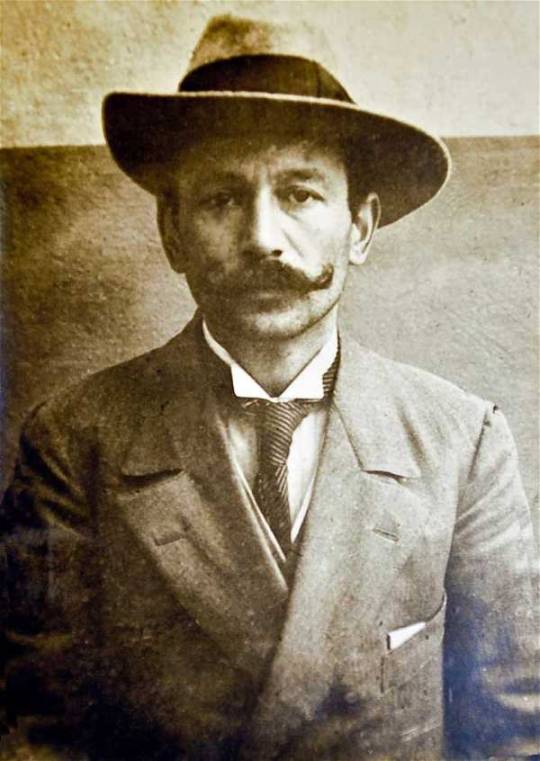

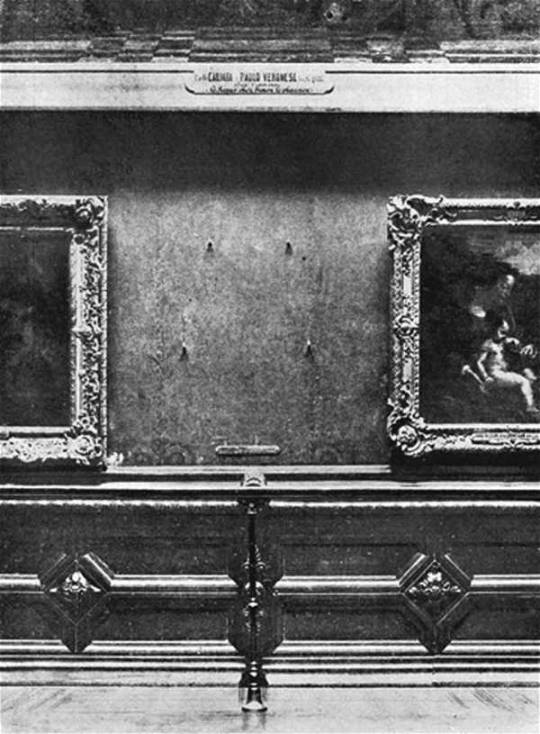
From left to right
Vincenzo Peruggia, the mastermind behind the Heist.
"Theft of Mona Lisa" (magazine cover) illustrated by Achille Beltrame, 1911.
Paris’s “mark of shame,” the empty space on the gallery wall where Mona had been displayed.
How he did it
Vincenzo Peruggia worked at the Louvre— he was a handyman and former Louvre employee familiar with the lay out, how the painting had been installed and museum procedures.
Security at the Louvre was low—unlike today’s high-tech security systems and CCTV, there was little in place during the early 20th century to stop criminals.
He had the help of 2 henchmen—brothers, Vincenzo and Michele Lancelotti assisted him with the theft.
It took over 2 years to catch him—He hid the painting in a false-bottom trunk in his apartment for 2 years while trying to find a buyer.
Details
Peruggia hid in a closet and waited for the gallery to close. with the help of his 2 accomplices, they lifted the artwork off the wall, removed its glass case and frame, and wrapped it up in a drop cloth. They smuggled the painting out of the museum, and nobody noticed it was missing for over twenty-four hours.
Because the Mona Lisa’s popularity exploded in the wake of the heist, Peruggia could not simply sell it as planned. After hiding the painting in his Paris apartment for 2 years, he finally attempted to sell it to an art dealer in Florence. Peruggia was arrested on the spot and the masterpiece was triumphantly returned to the Louvre with newfound notoriety to its name.
So it was actually Peruggia’s shady criminal activities that helped make the Mona Lisa famous around the world.

#mona lisa#vincenzo peruggia#art#mona lisa stolen#louvre#shoplifting at the louvre#j.p. morgan#pablo picasso#art theft#art heist#leonardo#leonardo da vinci#cliff clavin
72 notes
·
View notes
Text









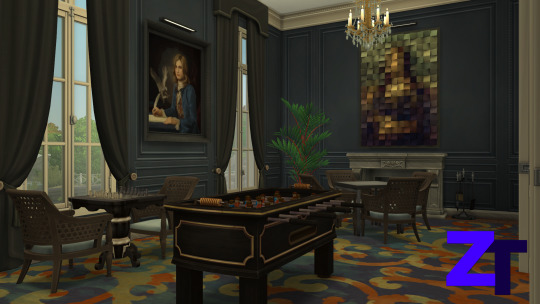












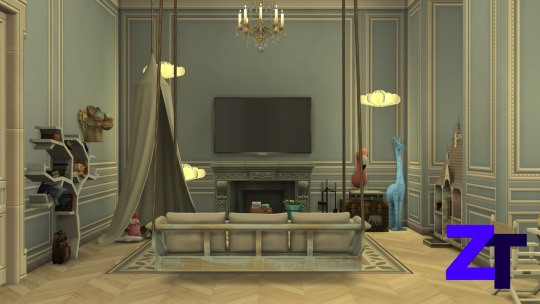






Renovated Chateau
My take on a renovated French Chateau. It's a combination of traditional architecture and modern furnishings. Fully Furnished CC Build.
Main level : entrance hall, central staircase, formal living room, games salon, formal dining room, kitchen/informal dining, half bathroom, cloak room and secundairy staircase/elevator to all floors.
Upper level : family living room, full bathroom, 2 large bedrooms and master apartment (with it's own dining/living area, full bathroom and walk-in closet).
Basement : half bathroom, gym/pool/sauna, full bathroom, butlers quarters (with a private bathroom), vault, laundry, utility room and storage room.
Greenhouse : with it's own vegetable garden
Guesthouse/garage : self contained guesthouse, comes with an open plan living/dining/kitchen, bedroom, full bathroom and closet.
Gardens : formal landscaped gardens and barbecue area
Lot size : 64x64, designed for the Hound's Head lot in Brindleton Bay. This build also looks good on the Dresden House lot in Windenburg.
Packs used for the exterior/shell/gardens : Get Together and Strangerville,. Jungle Adventures, Vampires and Cottage Living were used for some minor details. Many other packs used for the interior.
I won't upload a CC Free version since there too many elements in this build that just won't look good without CC in my opinion. On request I could send/upload the shell without CC though.
Available on the gallery, ID : zerotwenty-sims (please tick "include Custom Content", or download the TrayFiles directly below)
In case of any questions : please feel free to drop a line
Free CC used from following amazing creators:
ZT : Marble Murals Part II, Valium Painting
KTA : Classic Paintings 2, Marble Floors 4 and 5, Old Tiles 3 and Wood Floors 19
Harlix : Bafroom, Baysic + Baysic Bathroom, Orjanic, Jardane, Tiny Twafellers, Kichen and Harluxe
Felixandre : every pack (see note)
SkinnyAfter5 : Short Hedge
Ravasheen : Uplifting Elevator
SimFileShare : Tray Files
Note : I used Chateau Part 5 and Part 6 (library and the panel interior walls/curtains) which are still on Early Access. If you don't have these packs yet I suggest to replace the library with the library pack from Strange Storyteller Sims (free) and the panel walls/curtains with ones from Felixandre's previous packs like Paris, Florence, Trianon or London.
#sims 4 build#sims4#sims 4 screenshots#sims 4 download#sims 4#ts4 download#ts4 build#the sims 4#ts4 screenshots#ts4 lot#showusyourbuilds#cc build#zt-builds
72 notes
·
View notes
Text

Another joint Giovanni and Marsilio letter! This one to Naldo Naldi, who was Marsilio’s oldest friend. Like since they were children. Of the four letters to Naldo in the volumes, two of them are written jointly.
The ending to this letter to Naldo is Hilarious. Just like “we’re not inspired to be long winded, ciao bella”. Which to an old friend is a fine ending because obviously Naldo knew Marsilio (and Gio) loved him.
Gio & Marsilio: we love you but the muses aren’t talking to use right now. Love & kisses etc
Naldo:
Naldo: you two were either horny and distracted or down a platonic rabbit hole and distracted or some combo of the above.
Naldo: it’s fine.
I’m including the notes to this one because of the astrology references.

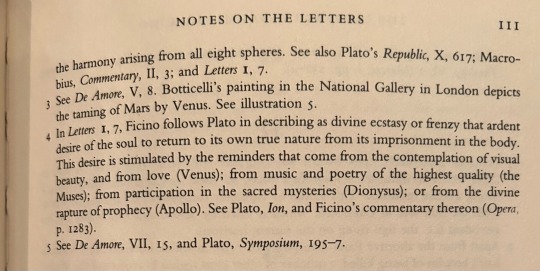
#marsilio ficino#Marsilio blogging#giovanni cavalcanti#Marsilio sourcing#early modern Florence#history#Renaissance Italy#Renaissance Florence#15th century
8 notes
·
View notes
Text
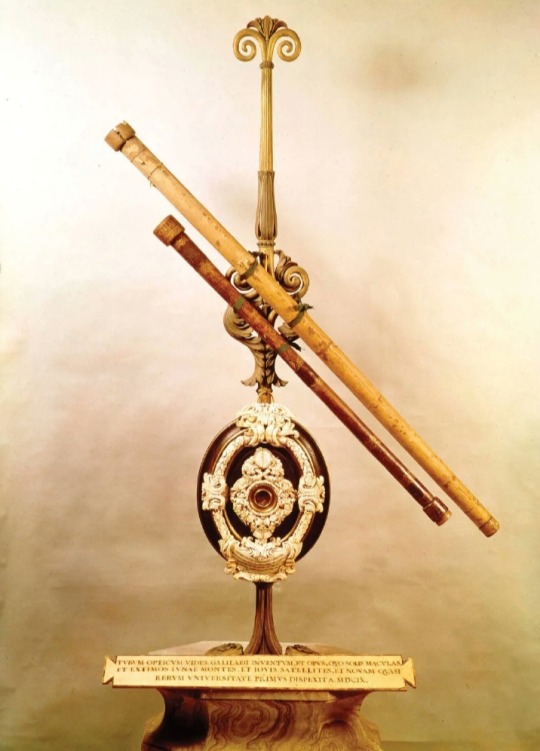
Galileo's first telescopes 🔭
Galileo's (1564-1642) early telescopes, which he constructed in the early 17th century (around 1609), marked a major advancement in observational astronomy.
These telescopes were based on the principles of existing Dutch telescopes, which had been developed by spectacle makers in the Netherlands.
These early telescopes, known as refracting telescopes, utilized a combination of lenses to gather and focus light, magnifying distant objects. Galileo further refined and improved their design.
The design of Galileo's telescopes typically consisted of a convex objective lens (the primary lens) and a concave eyepiece lens (the secondary lens).
The objective lens collected light from distant objects and converged it to a focal point, forming an image.
The eyepiece lens then magnified this image for the observer to see.
Galileo's telescopes had relatively low magnification power compared to modern telescopes, but they enabled him to make groundbreaking observations.
With these instruments, he made a series of significant discoveries, including:
Observations of the Moon
Galileo observed the rugged, mountainous surface of the Moon, challenging the prevailing belief in its perfect smoothness.
He also noticed the presence of craters and other lunar features.
Sunspots
It revealed that the Sun was not a perfect sphere and that it rotated on its axis
Discovery of Jupiter's moons
He observed four of Jupiter's largest moons, now known as the Galilean moons.
Their discovery provided evidence that not all celestial bodies orbited the Earth, challenging the geocentric model of the universe.
Phases of Venus
Galileo observed the phases of Venus, which he interpreted as evidence for the heliocentric model of the solar system proposed by Copernicus.
This observation suggested that Venus orbits the Sun and not the Earth.
Observation of Saturn
Galileo observed Saturn and its rings, although he was not able to discern the true nature of the rings due to limitations in his telescope's resolving power.
Galileo's telescopes revolutionized astronomy by providing concrete evidence that supported the Copernican heliocentric model of the solar system.
His observations and discoveries contributed to a profound shift in our understanding of the cosmos and laid the foundation for modern observational astronomy.
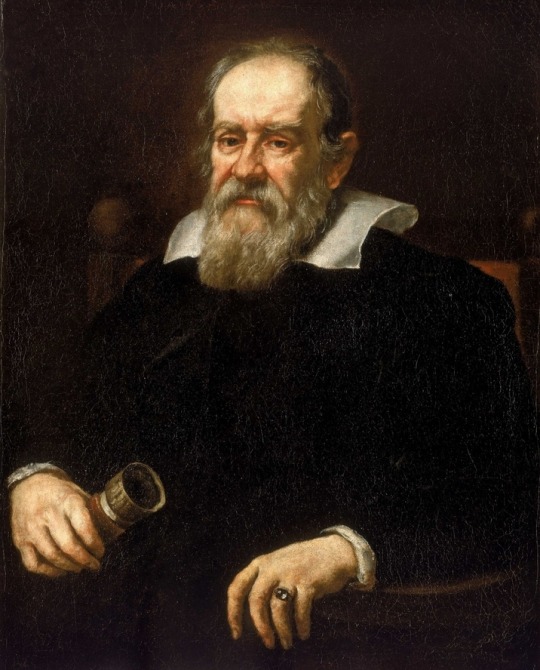
Galileo di Vincenzo Bonaiuti de' Galilei (15 February 1564 – 8 January 1642) was an Italian astronomer, physicist and engineer, sometimes described as a polymath.
He was born in the city of Pisa, then part of the Duchy of Florence.
Galileo has been called the "father of observational astronomy, modern-era classical physics, the scientific method, and modern science."
#Galileo di Vincenzo Bonaiuti de' Galilei#Galileo Galilei#telescopes#astronomy#observational astronomy#Galilean moons#refracting telescopes#moon#sunspots#Jupiter#Venus#Saturn#cosmos#planets#science#scientific discovery
64 notes
·
View notes
Text

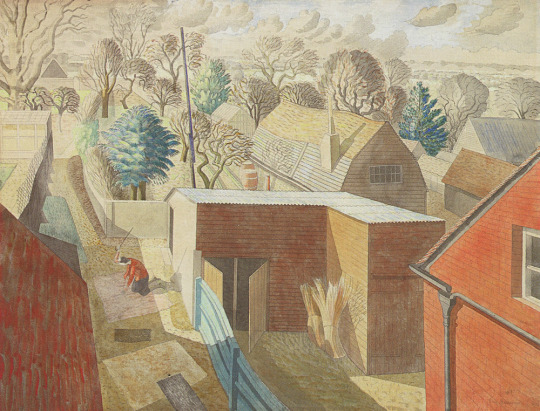


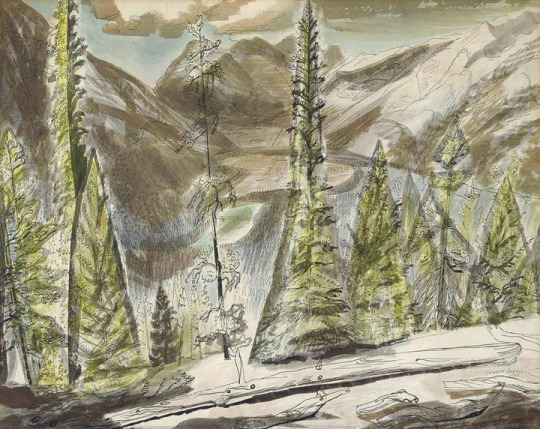
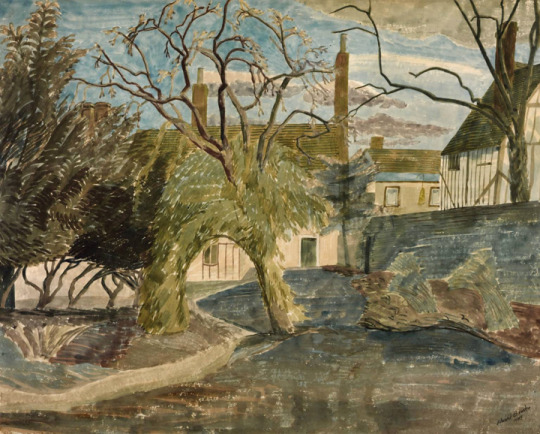

Watercolours by Edward Bawden (1903 – 1989, British).
"Edward Bawden (1903-1989) thought of himself as a designer, not an artist. A respected British book illustrator and printmaker, his commercial designs for clients including Fortnum & Mason and Shell, are rightly prized as classics. But as the Dulwich Picture Gallery in London argues, his fine art has been unfairly neglected. The gallery’s new exhibition, which features his paintings alongside his book illustrations, posters and graphic designs, ought to change that. The most comprehensive exhibition since his death, it argues that Bawden reinvented the watercolour for the 20th century.
Bawden is best known for his witty approach to linocut, a printing technique similar to woodcut, which he elevated into a respected medium. But as the exhibition reveals, Bawden was fascinated by watercolour. While he was at the Royal College of Art (rca), Bawden, his friend and fellow art student, Eric Ravilious, and their tutor, Paul Nash, rediscovered the British watercolourists of the late 18th and early 19th centuries. At the time – this was the 1920s – the restrained style of artists like Francis Towne and John Sell Cotman seemed refreshingly modern after decades of “blob” and “swash”, one critic’s disparaging terms for the loose style that grew out of Impressionism. In their own work, Bawden and his circle began to combine clean lines and precisely applied colour with stencilling and collage, and to borrow techniques from oil painting such as stippling, where the canvas is dotted with many small specks. In their hands, watercolour drawing went from fusty to fresh."
By Florence Hallett https://www.economist.com/.../how-edward-bawden...
26 notes
·
View notes
Note
i think a lot of viewers are used to characters who are oblivious/brush off their faults that when louis busts through the door with his self-critique like "hey i profited from the exploitation of women i'm ashamed and i'll do it again because i have an unhealthy relationship with power and i'll still be ashamed" they don't know how to deal with it
(side note: i do find it interesting that in order to feel manly louis to got into the sex industry)
i cant believe this has been sitting in my inbox cuz the last line is everything. to feel like a “man”, to get his family out the red “quicker”, he attaches himself to the sex industry. tom anderson was a real life politician w/ these very seedy ties to sexually exploitative practices in the gilded age/jim crow new orleans. in the show human/early vamp!louis being the only black man in these rooms w men like tom, fenwick+ the like, selling them the “product [of/was] desire” as his modern self words it is tied into his then-understanding of sex n what a “man” is meant to do . think of him saying “i aint touching no man dick!”, ep1 monologue where he admits to being “weak” [& what he recognizes in himself even in this moment of drunken madness..] ep2 identifying himself as “queer” in relation to lestat [who snarks back with “non-discriminating”] lestat helping him get the fair-play-now-renamed-azalea, his attempt at attempting to live a double life as the fledgling-creation-lover of lestat + the bigtimer of the iberville. all w/ him reading mrs. florence’s thoughts openly mocking him for not being “man enough”. some things men like him favor, indeed. itll never be enough. then ep3, the “favored” son is fully replaced when his favors no longer extend to them, the token black man in the room eats the city leader, the enterprises of desire collapse & louis is enmeshed into another web of gendered sexual dynamics. claudia, his redemption for formerly being a trick.

nice suit, lou.
#yn.#yn answers#iwtv#louis de pointe du lac#funnily enough the ep2 louis scene reminds me of when i came out to my stud friend & she was like girl u just greedy😂😂#‘U dont know what u want’ My friend🤝ep2 lou
82 notes
·
View notes
Text
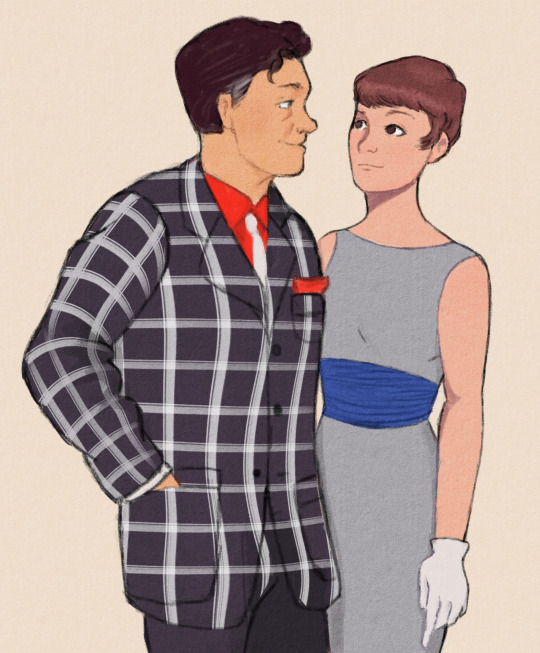
Well, at least she's a good-looking spy.
1962 Cuban Missile Crisis/Spy Movie Chess au for @because-i-love-chess for the Chess Cherver's Secret Santa exchange! Creative decisions/thoughts about the au below the cut!
Anatoly's outfit takes major inspo from the youth counterculture movement in Russia at the time! The Stilyagi! I thought this would be a good way to show how he's not a "proper," Russian, but in a way that still read early 60s as opposed to the more famous counterculture movements of the late 60s/70s. Stilyagi dressed very Western, with zoot suits, plaid, bright colors -- unfortunately there's not a lot of color photos of them that I found online, so I took some creative decisions, and looked at the 2008 movie musical about them! Funnily enough, this idea all started with Anatoly quoting a Cole Porter term in canon! Now, would Anatoly be able to get away with wearing Stilyagi fashion as such a public figure? Probably not, but I thought it was an interesting enough choice that I could handwave it. At this point, Russia had started becoming a bit more Westernized, and so the stilyagi are starting to fall out of fashion. However, Anatoly is still kinda clinging to his youth in a way, and to his idea of what America could be.
In contrast, Florence is very modern American. The hair, the silhouette -- it's not quite what the idea of the 60s we have in our heads yet, but it's tending towards that! I wanted her to read as up to date as possible because this Florence was an adult when she left Hungary! So she's deliberately trying to be as American as possible to avoid suspicion.There's no ties to Hungary in her appearance in this point in the show. I think this Florence is very involved in trying to get her father back, and she has rather more ties to the American government than usual.
In style, I wanted to try to pay homage to some of my favorite mid-century illustrators. Coby Whitmore and René Gruau were especially the ones I looked to for this. I tried to take influence from Gruau's color choices and his trick of black lineart on the outside, colored lineart on the inside. So, this was a little bit of a study for me in trying to learn from artists I really like too!
I have become quite fond of this au actually! I'd have to do more research for it to come to anything, but it's been fun harking back to the original concept for Chess, and I'd love to make more stuff for it.
#Chess#Chess the musical#Florence Vassy#Anatoly Sergievsky#Flonatoly#fanart#my art#artists on tumblr
38 notes
·
View notes